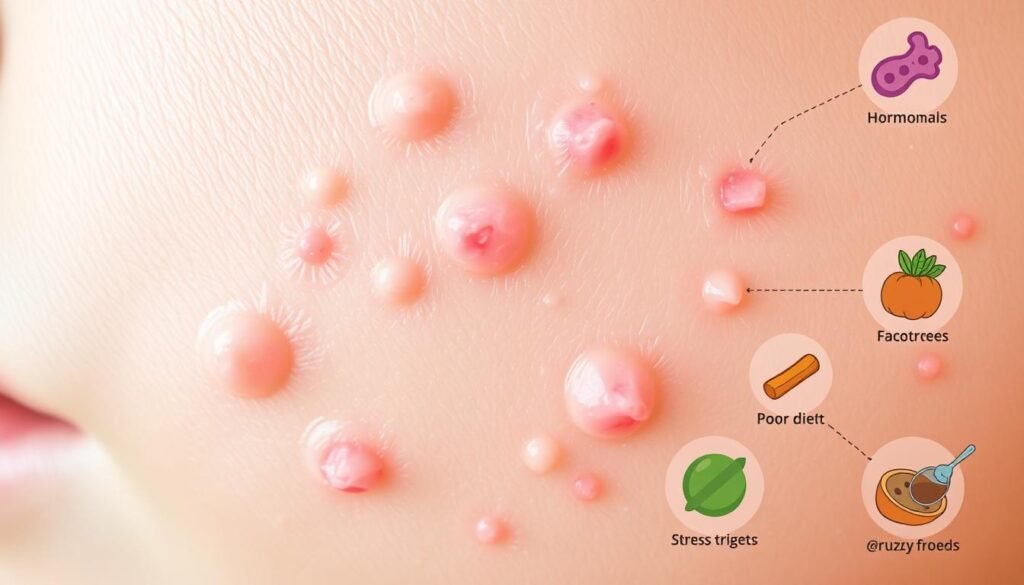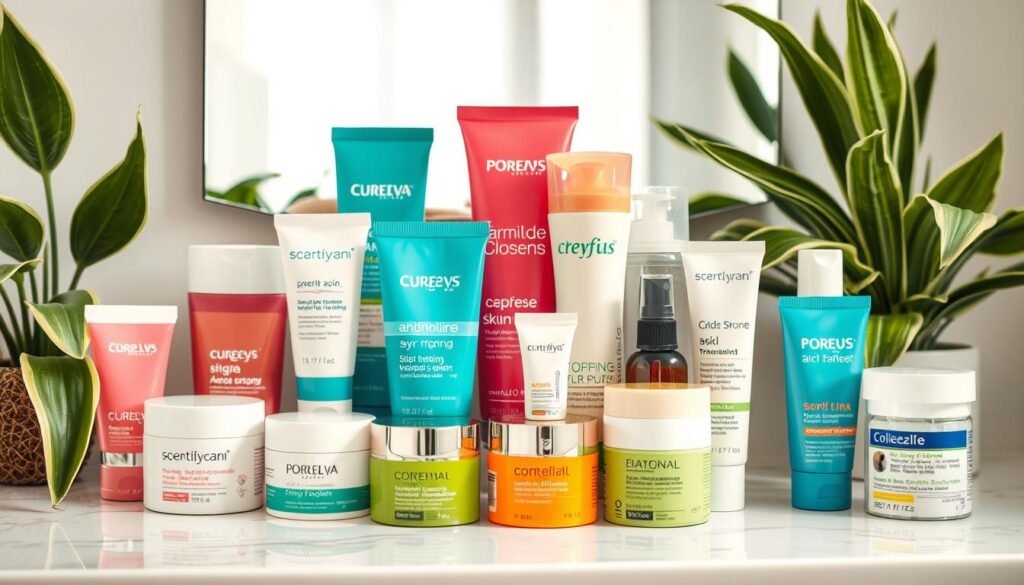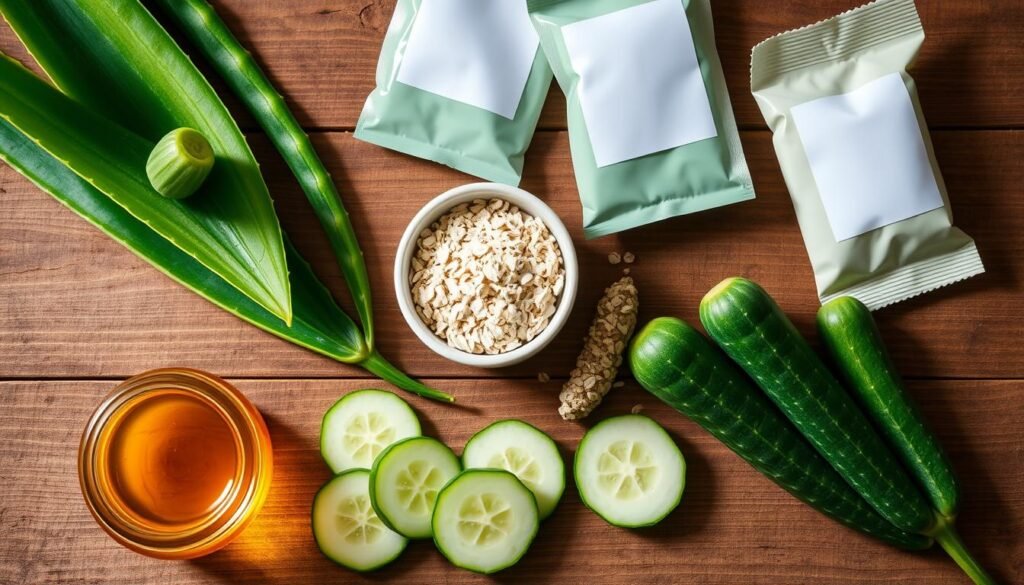Did you know acne touches 85 percent of young people? It’s a top skin issue worldwide. For many, soft acne pimples cause big worries and loss of confidence. Yet, knowing how to treat them can bring clear skin and new confidence. We’ll cover many treatments, from simple home tricks to pro advice. This info will help you choose the best acne care for you.
Key Takeaways
- Tender acne pimples are common among 85% of young adults.
- Effective acne treatment is essential for achieving clear skin.
- Various products and medications are available for treating acne.
- Understanding the root causes of acne can aid in prevention.
- Incorporating natural remedies can complement traditional treatments.
Understanding Tender Acne Pimples
Tender acne pimples are a skin problem many people face. What are pimples? They’re small, swollen spots caused by clogged hair follicles. These pimples look red, are swollen, and hurt because of the inflammation underneath the skin.
Different kinds of pimples can appear on the skin. For example:
- Pustules: These pimples are filled with pus and usually have a white or yellow middle.
- Cysts: These are big, deep spots that can hurt a lot and sometimes need a doctor’s help.
- Nodules: These are hard bumps under the skin that can be painful and might cause more problems.
Knowing the types of pimples helps in treating them right. About 50 million people in America deal with acne each year. And up to 85% of young people get acne at some point. Acne can be mild, moderate, or severe, depending on how many spots you have.
Mild acne has less than 30 spots, while severe acne has over 125. Tender acne pimples can happen because of hormone changes, stress, or some medications. If not treated early, acne can scar and mark the skin. Thankfully, there are many ways to care for acne, from home remedies to doctor-prescribed medicines. This means people can find the right treatment for their skin.
Common Causes of Tender Acne Pimples
Many factors lead to tender acne pimples, especially changes in hormones. Hormones fluctuate during puberty, menstrual cycles, and pregnancy. This can make oil production go up and pores to get blocked. So, this creates a good place for acne to start.
Skin bacteria also have a big role in causing tender acne. Too much oil and dead skin pile up. They give bacteria a perfect place to grow, which can make inflammation worse. It’s key to understand these causes to treat acne well.
Other things can make acne worse too. For example, genetics can make someone more likely to get acne. And, some people see that certain foods or products trigger their acne. Knowing these factors helps people choose the best care and treatment for their skin.

| Factor | Description |
|---|---|
| Hormonal Changes | Fluctuations during puberty, menstrual cycles, and pregnancy lead to increased oil production. |
| Skin Bacteria | Excess oil and dead skin cells create a breeding ground for bacteria, causing inflammation. |
| Genetics | Family history can increase the likelihood of developing tender acne pimples. |
| Product Reactions | Certain cosmetic products may trigger breakouts in sensitive skin types. |
| Diet | High glycaemic index foods may contribute to acne flare-ups in some individuals. |
Applying Ice for Immediate Relief
Using ice can quickly reduce swelling and pain from pimples. It narrows blood vessels, which lessens swelling and redness of acne. This method works well for cysts, nodules, pustules, and papules.
How Ice Helps Reduce Inflammation
Ice eases pain temporarily and makes swollen pimples less noticeable. It soothes the skin, but isn’t for blackheads or whiteheads. Add ice to your routine by using it after washing your face, morning and night.
Steps for Effective Ice Application
- Wrap a few ice cubes in a clean cloth or place them in a plastic bag.
- Gently apply the wrapped ice to the affected area for 3 to 4 minutes.
- Remove the ice and allow the skin to rest for about 10 minutes before reapplying if necessary.
- Do not apply the ice directly to bare skin to prevent frostbite or tissue damage.
- If you experience discomfort or persistent issues, consult a dermatologist for further treatment options.
Adding over-the-counter treatments, tea tree oil, or aloe vera to ice may boost its effectiveness. While ice alone won’t cure pimples, it can make them less visible for clearer skin.
| Type of Acne | Effect of Ice | Recommendation |
|---|---|---|
| Cysts | Reduces swelling and redness | Apply ice after cleansing |
| Nodules | Provides temporary pain relief | Wrap ice in a cloth |
| Pustules | Helps decrease inflammation | Use in short intervals |
| Papules | Minimizes visibility | Combine with spot treatments |
| Blackheads | Little to no effect | Avoid ice; use other treatments |
Over-the-Counter Pimple Treatments
Finding the right over-the-counter acne treatments can change how clear and healthy your skin looks. It’s key to know what’s in these products to treat pimples well. Many options are out there, and each fights acne in its way.
Choosing the Right Ingredients
Choosing the right ingredients is crucial in managing acne. You’ll find common elements in spot treatments for pimples such as:
- Salicylic Acid: In over-the-counter products, its strength goes from 0.5% to 2%. It helps by unclogging pores and stopping new pimples from forming.
- Benzoyl Peroxide: This ingredient comes in strengths from 2.5% to 10%. Studies show that lower levels work as well as higher ones to clear acne.
- Adapalene Gel: Also known as Differin, this retinoid has a 0.1% strength. It plays a big role in keeping pores clear and reducing breakouts.
- Azelaic Acid: At 10% strength, it fights inflammation and stops pores from clogging up. It also works well on dark spots.
Salicylic Acid vs. Benzoyl Peroxide
Salicylic acid and benzoyl peroxide are both great for treating acne, but they work differently:
| Ingredient | Mechanism | Best for |
|---|---|---|
| Salicylic Acid | Exfoliates skin and unclogs pores | Oily and acne-prone skin |
| Benzoyl Peroxide | Destroys acne-causing bacteria and reduces oil | Mild to moderate cystic acne |
Getting visible results may take weeks of regular use. Stick with a daily skin care plan to see the best results. This includes washing your face twice a day with a gentle cleanser. If you don’t see changes after 2 or 3 months, it’s smart to talk to a healthcare expert.

Gentle Acne Solutions for Sensitive Skin
Finding the right Gentle Acne Solutions for sensitive skin is crucial. People with sensitive skin struggle with harsh treatments. That’s why calming ingredients like chamomile and calendula are perfect. They offer Soothing Pimple Care and effectively manage acne.
For light acne, benzoyl peroxide can help, but it may dry out or irritate sensitive skin. Salicylic acid is a gentler option that fights acne well. Yet, it may still cause some itching or discomfort.
Other good choices include azelaic acid, lactic acid, mandelic acid, and low levels of retinol. Azelaic acid is great because it exfoliates, fights bacteria, and has fewer side effects. Plus, it won’t make your skin more sensitive to the sun, which is a bonus for those with sensitive skin.
| Ingredient | Benefits | Possible Side Effects |
|---|---|---|
| Benzoyl Peroxide | Effective for mild acne | Dryness, redness, peeling |
| Salicylic Acid | Gentler alternative | Itching, peeling, irritation |
| Azelaic Acid | Exfoliates and antibacterial | Burning, stinging, dryness |
| Lactic Acid | Gentle exfoliation | Possible irritation |
| Mandelic Acid | Good for sensitive skin | Mild irritation |
| Retinol | Improves skin texture | Peeling, redness |
Comfort is key when treating acne on sensitive skin. Use mineral sunscreens like titanium dioxide or zinc oxide for irritation-free sun protection. A routine filled with gentle products will guide people through acne care.
Looking for more tips on adult acne management? Check out this resource for professional advice.
Soothing Pimple Care: Natural Remedies
Natural Acne Remedies are becoming more popular. They help manage tender pimples with less irritation. Essential oils are a top choice for this, thanks to their ability to fight germs. This part talks about the benefits of these oils. It also covers the cool, calming powers of aloe vera, a key player in natural skin care.
Essential Oils and Their Benefits
Essential oils are great for fighting acne-causing bacteria. A study in 2019 showed that products containing tea tree oil can greatly lower acne sores. This is because of their germ-fighting power. Adding essential oils like tea tree to your skin care plan offers a natural way to clear up skin blemishes.
Benefits of Aloe Vera and Tea Tree Oil
Aloe vera is amazing for taking care of pimples. In 2021, research showed that using aloe vera with ultrasound and soft masks made skin bumps go down. It also made the skin more moist. Aloe vera is perfect for reducing redness and swelling.
Tea tree oil is great for healing, too. It fights bacteria and helps calm irritated skin. Together, aloe vera and tea tree oil make a powerful combo for skin care.

| Natural Ingredient | Benefits |
|---|---|
| Tea Tree Oil | Reduces acne sores and targets bacteria |
| Aloe Vera | Soothes skin and hydrates while calming inflammation |
| Cucumber | Reduces irritation and swelling |
| Honey | Promotes healing and inhibits bacterial growth |
| Green Tea Extract | Reduces whiteheads and promotes healthy skin |
Applying Face Masks for Acne Relief
Face masks are key for better skin health and fighting acne. The right mask can greatly help with acne issues. Each mask is made for different skin types and problems. Knowing what ingredients work best can improve your skin care.
Choosing the Right Face Mask
It’s vital to pick a mask based on your skin type. Dry skin benefits from moisturizing gel or cream masks. Oily skin does well with clay masks that remove oil and dirt. And sensitive skin needs gentle, soothing masks to calm irritation.
Ingredients to Look for in Acne-Fighting Masks
Good face masks include ingredients that target acne. Look for these key components:
- Clay – It pulls out dirt and oil, which is great for oily skin.
- Charcoal – Detoxifies the skin and removes impurities.
- Salicylic Acid and Benzoyl Peroxide – These fight active acne and prevent new breakouts.
- Sulfur – Reduces inflammation, an old remedy for acne.
- Glycolic Acid – Helps remove dead skin cells, renewing the skin.
Use masks regularly, at least once a week, for better skin over time. Always clean your face before applying a mask. Use clean hands or a brush to apply, and follow how long to leave it on. For detailed info on masks, check out this guide on face masks.
The Role of Professional Treatments
When acne is tough, basic cleaners might not be enough. Seeing a Dermatologist for Acne means getting Professional Acne Treatments made just for you. It’s crucial for difficult acne types, like acne conglobata or the kind caused by medication.
Acne does more than damage skin. It can hurt how we feel about ourselves and affect our interactions. Getting clear skin might mean trying creams, pills, or light treatments. Prescribed treatments can work in four to eight weeks, which is faster than store-bought products.
Common treatments may include:
- Topical retinoids: They can cut down on spots and inflammation by 40% to 70%.
- Antimicrobials: Ingredients like benzoyl peroxide and antibiotics greatly reduce inflamed spots.
- Cortisone injections: They offer quick help by making angry pimples smaller and less painful.
- Isotretinoin: Perfect for tough acne that hasn’t improved with other methods.
- Oral contraceptives: These are birth control pills that the FDA has approved to treat acne in women.
Using more than one treatment usually works better than a single one. Mixing retinoids with antibiotics, for instance, can fight acne on several fronts. Treatment plans consider how bad the acne is, how old you are, your skin type, and what you’ve tried before.
Going for professional Acne Care means getting the right help. This way, your skin gets the best possible chance to become and stay healthy.
Tender Acne Pimples and Makeup Choices
Finding the right makeup for acne-prone skin matters a lot. It’s key to choose noncomedogenic makeup to keep pores open. This makeup helps avoid worsening acne while concealing blemishes.
Look for makeup with anti-inflammatory qualities. Some have ingredients like salicylic acid to treat and cover at the same time. Choose oil-free foundations and tinted moisturizers to hydrate without adding oil.
Acne affects many, especially in the teen years and beyond. Women often deal with it more as adults. It’s important to know how skincare interacts with acne. Many brands have products for sensitive skin to reduce irritation.
A solid skincare routine is crucial for managing acne with makeup. Use gentle cleansers and follow a dermatologist’s advice closely. For customized skincare and makeup tips, check out expert advice on acne dos.
Building a Consistent Skin Care Routine
A good Skin Care Routine for Acne is key in handling sensitive acne effectively. It helps clean away too much oil and keeps your pores clear. This minimizes breakouts and supports healthier skin.
- Gentle Cleansing: Use gentle products like Neutrogena Ultra Daily Face Wash for Sensitive Skin. This cleans without harming your skin.
- Moisturizing: Choose a good moisturizer that controls oil but doesn’t block pores. Look for oil-free, noncomedogenic kinds.
- Spot Treatment: Use salicylic acid or benzoyl peroxide for direct pimple care. This is a crucial part of a Consistent Acne Treatment.
Don’t forget these important steps:
- Wear SPF every day to protect against UV damage, especially when using products that make your skin more sensitive.
- Add a double cleansing step at night, especially if you wear makeup or if your skin is oily.
Talking regularly with a dermatologist helps with special skin issues. They can recommend specific products for different skin types and problems. Following a Daily Skin Care regimen leads to clearer skin and fewer breakouts. For more info on forehead acne causes, check out this resource.
Conclusion
Dealing with tender acne pimples means using different methods and plans. You can try immediate fixes like putting ice on the spot. Also, there are over-the-counter options to help clear the skin. Knowing about gentle and natural ways can also help fight acne.
Being patient is crucial when handling acne. You might start seeing better skin in 2 to 3 months. Many people, especially those 12 to 24 years old, deal with acne. This shows how vital clear skin methods are for both teens and adults. Talking to experts and picking the right products can make beating acne easier.
With the right treatment knowledge and lifestyle choices, you can feel more confident in controlling your skin health. Having a regular skin care routine and getting treatments that fit your needs are important. This helps in the fight against tender acne pimples.